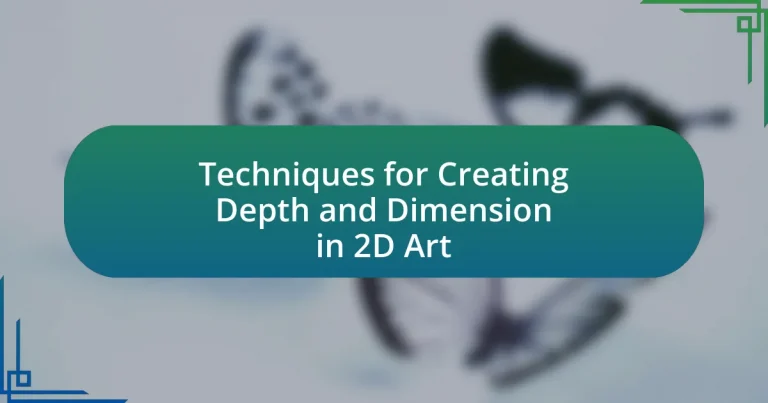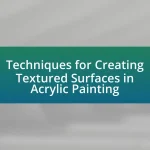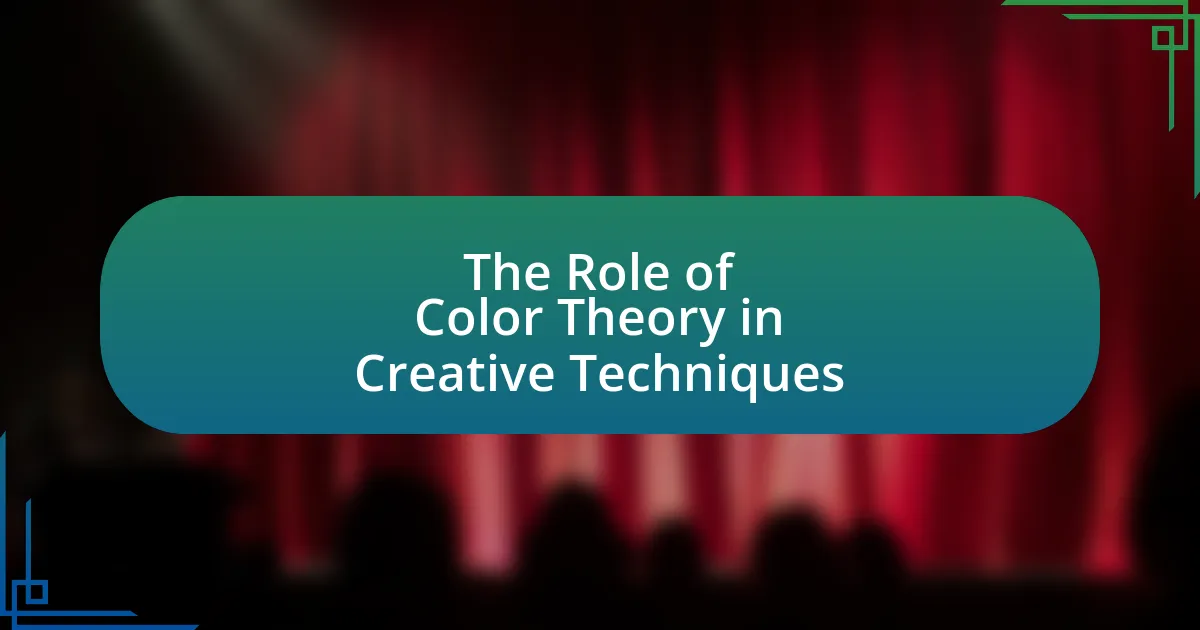The article focuses on techniques for creating depth and dimension in 2D art, highlighting methods such as linear perspective, atmospheric perspective, overlapping, shading, and scale. It explains how artists utilize these techniques to simulate three-dimensional space on a flat surface, enhancing viewer engagement and emotional response. Key concepts include the role of perspective in depth perception, the impact of color and light on dimensionality, and practical tips for artists to improve their skills in depicting depth. Additionally, the article addresses common mistakes artists make regarding depth and offers resources for mastering these techniques.

What are the Techniques for Creating Depth and Dimension in 2D Art?
Techniques for creating depth and dimension in 2D art include linear perspective, atmospheric perspective, overlapping, shading, and scale. Linear perspective involves using converging lines to create the illusion of depth, as seen in works by artists like Leonardo da Vinci, who utilized this technique to enhance spatial realism. Atmospheric perspective relies on color and clarity changes to suggest distance, where objects appear lighter and less detailed as they recede into the background. Overlapping elements in a composition can also indicate depth, as objects that obscure others appear closer to the viewer. Shading techniques, such as hatching and cross-hatching, add volume and form to objects, enhancing their three-dimensionality. Finally, varying the scale of objects within a scene can create a sense of depth, as larger objects appear closer while smaller ones seem further away. These techniques are foundational in art and have been employed by artists throughout history to create immersive visual experiences.
How do artists create the illusion of depth in their work?
Artists create the illusion of depth in their work through techniques such as linear perspective, atmospheric perspective, and the use of overlapping elements. Linear perspective involves creating a vanishing point on the horizon line, where parallel lines converge, giving the viewer a sense of three-dimensional space. Atmospheric perspective uses color and clarity to suggest depth; objects in the distance appear lighter and less detailed than those in the foreground. Overlapping elements help establish spatial relationships by placing one object in front of another, visually indicating which is closer. These methods are grounded in principles of visual perception and have been utilized since the Renaissance, as evidenced by works like Leonardo da Vinci’s “The Last Supper,” which effectively employs these techniques to create a convincing sense of depth.
What role does perspective play in creating depth?
Perspective is crucial in creating depth in 2D art as it simulates three-dimensional space on a flat surface. By employing techniques such as linear perspective, where parallel lines converge at a vanishing point, artists can create the illusion of distance and volume. This method is supported by the principles of geometry, which demonstrate how objects appear smaller as they recede into the background, effectively guiding the viewer’s eye and enhancing the sense of depth.
How can overlapping objects enhance the perception of space?
Overlapping objects enhance the perception of space by creating a visual hierarchy that suggests depth. When one object partially covers another, it indicates that the covered object is further away in the spatial arrangement, allowing the viewer to interpret the relative distances between objects. This technique is supported by principles of visual perception, where overlapping is recognized as a cue for depth perception, as demonstrated in studies on visual processing, such as those by Palmer (1999) in “Vision Science: Photons to Phenomenology,” which highlight how the brain interprets overlapping shapes to gauge spatial relationships.
What visual elements contribute to a sense of dimension?
Visual elements that contribute to a sense of dimension include perspective, shading, color gradients, and overlapping forms. Perspective creates the illusion of depth by simulating how objects appear smaller as they recede into the distance, following the principles established by artists like Leonardo da Vinci. Shading adds volume and form to objects by depicting light and shadow, which can be observed in the chiaroscuro technique used by Caravaggio. Color gradients enhance depth perception by using warmer colors in the foreground and cooler colors in the background, a method supported by atmospheric perspective principles. Overlapping forms create a spatial relationship between objects, making it clear which elements are in front and which are behind, a technique frequently utilized in landscape painting.
How does color influence depth perception in 2D art?
Color significantly influences depth perception in 2D art by creating visual cues that suggest spatial relationships. Warm colors, such as reds and yellows, tend to appear closer to the viewer, while cool colors, like blues and greens, recede into the background. This phenomenon is supported by the principles of atmospheric perspective, where distant objects are depicted with cooler, less saturated colors to simulate the effect of the atmosphere on visibility. Research by Paul D. M. Dijkstra and colleagues in “Color and Depth Perception” (2018) demonstrates that color contrast enhances the perception of depth, as higher contrast between foreground and background colors makes objects appear more three-dimensional.
What is the impact of light and shadow on dimensionality?
Light and shadow significantly enhance the perception of dimensionality in two-dimensional art. By creating contrasts, light and shadow simulate depth, making flat images appear three-dimensional. For instance, the use of chiaroscuro, a technique that employs strong contrasts between light and dark, can define shapes and contours, giving the illusion of volume and space. This effect is supported by the principles of visual perception, where the human brain interprets variations in light intensity as cues for depth. Studies in art theory, such as those by art historian Ernst Gombrich, emphasize that effective manipulation of light and shadow is crucial for achieving realistic representations in 2D art.
Why is understanding depth important for 2D artists?
Understanding depth is crucial for 2D artists because it enhances the perception of three-dimensional space on a flat surface. By mastering techniques such as overlapping, size variation, and atmospheric perspective, artists can create a more realistic and engaging visual experience. Research indicates that effective use of depth can significantly improve viewer engagement and emotional response, as demonstrated in studies on visual perception and art appreciation.
How does depth affect the viewer’s emotional response?
Depth significantly influences the viewer’s emotional response by creating a sense of realism and immersion in the artwork. When depth is effectively portrayed through techniques such as overlapping, size variation, and atmospheric perspective, it enhances the viewer’s connection to the scene, evoking feelings of nostalgia, tranquility, or tension. Research indicates that artworks with a strong sense of depth can elicit more intense emotional reactions, as they engage the viewer’s perception and imagination, making the experience more relatable and impactful. For instance, a study published in the journal “Psychological Science” by authors such as Palmer and Kosslyn found that depth cues in visual art can lead to increased emotional engagement, demonstrating that depth not only serves a compositional purpose but also plays a crucial role in shaping emotional experiences.
What are the common mistakes artists make regarding depth?
Common mistakes artists make regarding depth include neglecting perspective, misusing scale, and failing to create contrast. Neglecting perspective leads to flat compositions, as artists may not accurately depict how objects recede into space. Misusing scale can result in unrealistic relationships between objects, making them appear disconnected. Failing to create contrast, both in color and value, diminishes the sense of depth, as elements may blend together rather than stand out. These mistakes hinder the overall effectiveness of depth in 2D art, impacting the viewer’s perception and engagement.
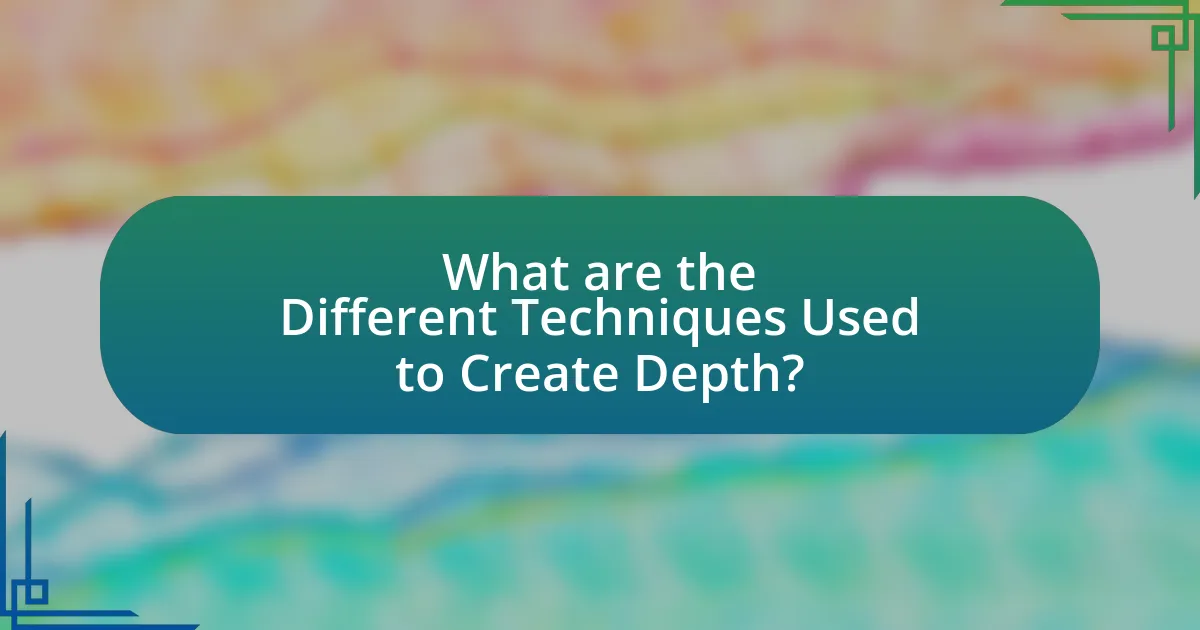
What are the Different Techniques Used to Create Depth?
Different techniques used to create depth in 2D art include linear perspective, atmospheric perspective, overlapping, size variation, and shading. Linear perspective involves using converging lines to simulate depth, as seen in works by artists like Leonardo da Vinci, where parallel lines appear to converge at a vanishing point. Atmospheric perspective relies on color and clarity changes to suggest distance; objects further away appear lighter and less detailed, a technique effectively utilized by Claude Monet. Overlapping occurs when one object partially covers another, creating a sense of spatial relationship. Size variation indicates that larger objects appear closer while smaller ones seem further away, a principle evident in many landscape paintings. Shading adds volume and dimension by creating contrasts between light and shadow, enhancing the three-dimensional illusion. These techniques are foundational in art, allowing artists to convey depth effectively.
How can line and shape be utilized to suggest depth?
Line and shape can suggest depth by creating a sense of perspective and spatial relationships in two-dimensional art. For instance, converging lines, such as those found in linear perspective, lead the viewer’s eye toward a vanishing point, enhancing the illusion of depth. Additionally, overlapping shapes can indicate which objects are closer or further away, as the shapes that obscure others appear nearer to the viewer. This technique is supported by the principles of visual perception, where the brain interprets overlapping and converging elements as indicators of spatial hierarchy.
What is the significance of contour lines in creating dimension?
Contour lines are significant in creating dimension as they define the shape and form of objects in a two-dimensional space. By varying the thickness and darkness of these lines, artists can suggest depth, volume, and perspective, allowing viewers to perceive three-dimensionality on a flat surface. For instance, in topographic maps, contour lines indicate elevation changes, visually representing hills and valleys, which reinforces the concept of dimensionality. This technique is foundational in art and design, as it helps convey realistic representations and spatial relationships within the artwork.
How do geometric shapes contribute to a three-dimensional effect?
Geometric shapes contribute to a three-dimensional effect by creating the illusion of depth through perspective and spatial relationships. When artists use geometric shapes, they can manipulate size, overlap, and alignment to simulate how objects appear in three-dimensional space. For example, larger shapes appear closer to the viewer, while smaller shapes suggest distance, effectively guiding the viewer’s eye and enhancing the perception of depth. Additionally, the use of light and shadow on these shapes can further reinforce the three-dimensionality, as it mimics how light interacts with objects in the real world. This technique is foundational in art, as evidenced by the principles of linear perspective established during the Renaissance, which utilized geometric shapes to create realistic spatial depth in two-dimensional works.
What techniques can be employed to manipulate scale and proportion?
Techniques to manipulate scale and proportion in 2D art include the use of overlapping elements, varying sizes of objects, and perspective techniques. Overlapping elements create a sense of depth by positioning objects in front of one another, which visually indicates their relative distance. Varying sizes of objects can emphasize importance or create a focal point; for instance, larger objects appear closer while smaller ones seem further away. Perspective techniques, such as linear perspective, utilize vanishing points to create the illusion of depth, making objects appear smaller as they recede into the background. These methods are foundational in art and design, as they effectively guide the viewer’s perception of space and dimension.
How does the size of objects affect the perception of distance?
The size of objects significantly affects the perception of distance, as larger objects appear closer while smaller objects seem farther away. This phenomenon is rooted in the principles of visual perception, where the brain interprets size relative to distance; for instance, an object that occupies a larger visual angle is perceived as being nearer. Research in psychology, such as the work by Gregory (1997) in “Eye and Brain: The Psychology of Seeing,” supports this by demonstrating that size cues are critical in depth perception. Thus, artists can manipulate object size in 2D art to create an illusion of depth, guiding viewers’ perceptions of spatial relationships within the artwork.
What is the role of foreshortening in 2D art?
Foreshortening in 2D art serves to create the illusion of depth and three-dimensionality by depicting objects or figures in a way that mimics their appearance when viewed from a specific angle. This technique involves altering the proportions of the subject, making parts closer to the viewer appear larger while those further away appear smaller, effectively simulating perspective. Historical examples include the works of Renaissance artists like Andrea Mantegna, who utilized foreshortening to enhance realism and spatial dynamics in compositions, demonstrating its effectiveness in engaging viewers and conveying a sense of volume.
How can texture be used to enhance depth perception?
Texture enhances depth perception by creating visual cues that simulate three-dimensionality in two-dimensional art. When artists apply varying textures, they can suggest distance and form; for instance, rough textures can appear closer while smoother textures may seem further away. This phenomenon is supported by the principle of texture gradient, where the density and detail of texture decrease with distance, allowing viewers to interpret spatial relationships more effectively. Research indicates that textured surfaces can significantly influence the perception of depth, as demonstrated in studies on visual perception, such as those conducted by Palmer and Kosslyn, which show that texture plays a critical role in how we perceive spatial arrangements.
What types of textures are most effective for creating dimension?
The most effective textures for creating dimension in 2D art include rough, smooth, and layered textures. Rough textures, such as those created with impasto techniques or textured mediums, add visual interest and depth by casting shadows and highlights. Smooth textures, often found in gradients or blended areas, can create a sense of space and distance. Layered textures, achieved through techniques like collage or mixed media, enhance dimensionality by providing varying levels of depth and complexity. These textures are supported by principles of visual perception, where contrast and variation in surface quality can significantly influence the viewer’s experience of depth.
How does the application of texture vary between different mediums?
The application of texture varies significantly between different mediums, as each medium has unique properties that influence how texture is created and perceived. In painting, for example, oil paints allow for thick impasto techniques that create a three-dimensional effect, while watercolors produce softer, more fluid textures that blend seamlessly. In printmaking, techniques like etching or linocut can create distinct, tactile surfaces that differ from the smoothness of digital prints. Additionally, collage incorporates various materials, such as paper and fabric, to introduce diverse textures that enhance visual interest. Each medium’s inherent characteristics dictate the methods and outcomes of texture application, impacting the overall depth and dimension in 2D art.
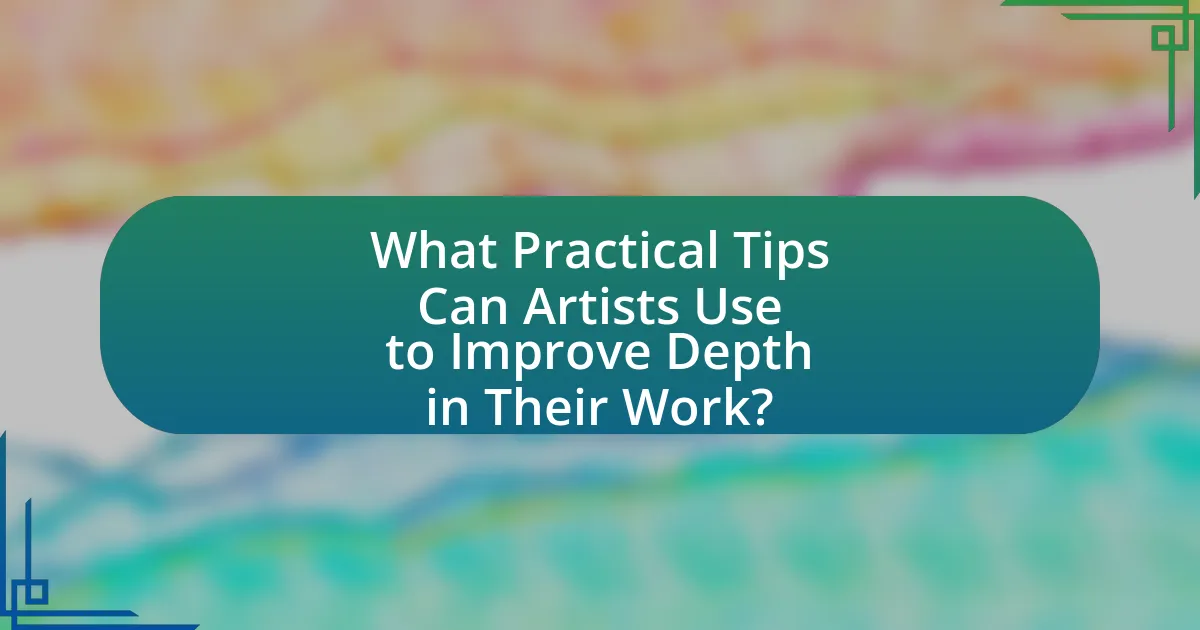
What Practical Tips Can Artists Use to Improve Depth in Their Work?
Artists can improve depth in their work by utilizing techniques such as atmospheric perspective, layering, and contrasting values. Atmospheric perspective involves using color and clarity to create the illusion of distance; for example, objects in the background appear lighter and less detailed than those in the foreground. Layering adds physical and visual depth by overlapping elements, which can create a sense of space and dimension. Additionally, contrasting values—using a range of light and dark tones—enhances the three-dimensionality of forms, making them appear more realistic. These methods are supported by principles of visual perception, which indicate that our eyes interpret depth through variations in color, clarity, and contrast.
How can artists practice creating depth in their compositions?
Artists can practice creating depth in their compositions by employing techniques such as overlapping elements, varying sizes, and utilizing atmospheric perspective. Overlapping elements allows artists to place objects in front of one another, visually indicating which are closer to the viewer. Varying sizes helps to create a sense of scale, where larger objects appear closer and smaller ones seem further away. Atmospheric perspective involves using color and clarity to suggest depth; objects in the background are often lighter and less detailed than those in the foreground. These methods are supported by principles of visual perception, which indicate that our brains interpret spatial relationships based on these cues.
What exercises can help develop an understanding of perspective?
Exercises that can help develop an understanding of perspective include drawing from life, practicing one-point and two-point perspective grids, and creating a series of sketches that focus on overlapping objects. Drawing from life allows artists to observe and replicate the way objects recede into the background, enhancing their grasp of spatial relationships. Utilizing one-point and two-point perspective grids provides structured frameworks for understanding how lines converge at vanishing points, which is essential for creating depth. Additionally, sketching overlapping objects helps artists visualize how perspective affects the placement and size of elements in a composition, reinforcing the concept of foreground and background. These exercises are widely recognized in art education for their effectiveness in teaching perspective.
How can artists analyze existing works to learn about depth techniques?
Artists can analyze existing works by closely observing the use of perspective, layering, and color to understand depth techniques. By examining how artists implement linear perspective, such as vanishing points and horizon lines, they can grasp how spatial relationships are created. Additionally, studying the layering of elements, where foreground, middle ground, and background are distinctly defined, reveals how depth is achieved through composition. Color theory also plays a crucial role; artists can learn how warmer colors appear closer while cooler colors recede, enhancing the illusion of depth. Analyzing renowned works, such as those by Leonardo da Vinci or Claude Monet, provides concrete examples of these techniques in action, demonstrating their effectiveness in creating a three-dimensional feel on a two-dimensional surface.
What tools and resources are available for mastering depth in 2D art?
To master depth in 2D art, artists can utilize tools such as perspective grids, layering techniques, and digital software like Adobe Photoshop or Procreate. Perspective grids help establish accurate vanishing points and horizon lines, which are essential for creating realistic depth. Layering techniques involve placing objects at varying distances from the viewer, enhancing the illusion of depth through overlapping elements. Digital software offers features like 3D modeling and depth maps, allowing artists to experiment with spatial relationships and lighting effects. These resources are widely recognized in art education and practice, providing foundational skills for achieving depth in 2D compositions.
What software can assist in visualizing depth in digital art?
Software that can assist in visualizing depth in digital art includes Adobe Photoshop, Corel Painter, and Clip Studio Paint. Adobe Photoshop offers tools like layers and blending modes that help artists create a sense of depth through shading and perspective. Corel Painter provides natural media brushes that simulate traditional painting techniques, allowing for depth through texture and color variation. Clip Studio Paint features 3D models and perspective rulers that aid in accurately depicting depth in illustrations. These software options are widely used in the digital art community for their robust features that enhance depth visualization.
How can books and tutorials enhance an artist’s skills in creating dimension?
Books and tutorials enhance an artist’s skills in creating dimension by providing structured knowledge and practical techniques. They offer insights into concepts such as perspective, shading, and composition, which are essential for achieving depth in 2D art. For instance, books like “Drawing on the Right Side of the Brain” by Betty Edwards explain how to perceive and render three-dimensional forms on a two-dimensional surface. Tutorials often include step-by-step demonstrations that allow artists to practice these techniques in real-time, reinforcing learning through application. Research indicates that structured learning resources significantly improve skill acquisition in visual arts, as they provide both theoretical understanding and practical exercises that artists can replicate.
